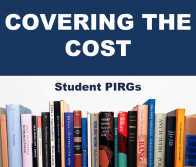 Ethan Senack and Robert Donoghue
Ethan Senack and Robert Donoghue
Report for Student PIRGs (CC-BY)
Full Study | Executive Summary Follows:
Over the last decade, the cost of college textbooks has soared. Since 2006, the cost of a college textbook increased by 73% – over four times the rate of inflation. Today, individual textbooks often cost over $200, sometimes as high as $400.
Textbook prices have increased unabatedly because the textbook market lacks two major economic forces:
| Normal Market | Textbook Market |
|
|
For nearly 30 straight years, textbook publishers have exploited their unchecked power in the market through a variety of tactics designed to drive up the cost of new books, and undermine cheaper market alternatives like used textbook programs.
However: since textbook sticker prices appear small in comparison with the larger costs of tuition or room and board, they are often overlooked, and addressing this problem is often deprioritized.
At the same time, no research to date — including our own — has attempted to investigate the degree at which prices actually affect student’s financial standing and behavior. As a result, the case for prioritizing action around textbook prices has lacked urgency and potency.
The result of a nationwide survey of nearly 5,000 students, this report introduces a new dimension to our understanding of the problem: that high textbook prices are serious cause for concern about our students’ financial well-being.
Survey Findings
FINDING 1: A SIGNIFICANT NUMBER OF STUDENTS TURN TO FINANCIAL AID TO
PURCHASE THEIR REQUIRED TEXTBOOKS.
Nearly one-third (29.7%) of students replied that they had used financial aid to pay for their textbooks. This is a startlingly large result, considering that student aid is typically applied to direct expenses such as tuition, room and board before being used for textbooks and other expenses.
If applied to the enrolled undergraduate population in the United States, this finding means that over 5.2 million students use financial aid to purchase their textbooks.ii
FINDING 2: FOR THE STUDENTS THAT USE FINANCIAL AID ON BOOK, IT’S USED TO COVER A MAJOR PORTION OF THE TOTAL EXPENSE.
For those that used financial aid, the amount of financial aid dollars they put toward purchasing textbooks was more than $300 on
average per semester.
FINDING 3: HIGH TEXTBOOK PRICES HAVE A DISPROPORTIONATE IMPACT ON STUDENTS AT COMMUNITY COLLEGE.
When broken down by type of college, our data show that a greater percentage of community college students use financial aid to purchase textbooks:
- 28% at 4-year public colleges
- 22% at 4-year private institutions
- 50% at 2-year & community colleges
Analysis
TEXTBOOK PRICES ADD UNNECESSARY FINANCIAL HARDSHIP:
Of the students using financial aid for textbooks, the average amount used is more than $300 per semester. That adds to $2,400 over the course of a four-year program, and $1,200 for two years at community college. That’s nearly the cost of adding an entire extra semester for a community college student. The ultimate cost is even higher for a student who uses loans to cover that cost: a $2,400 and $1,200 student loan translates into $555.55 and $277.73 worth of interest respectively. Put another way, a student using loans would pay an additional $34.72 for a $150 textbook. While a student with the ability to buy books outright pays sticker price, a student using financial may actually end up paying a higher price for course materials.
TEXTBOOK PRICES PLAY AN NEGATIVE ROLE IN STUDENT CHOICE POINTS:
In comparison with the tens of thousands of dollars spent on tuition or board, a few hundred dollars for textbooks is often overlooked, and written off as negligible. However, research shows that comparatively small amounts of money can have a disproportionate impact: at Morgan State University, a study showed that 10% of students dropping out for financial reasons owed the University less than $1000. That’s less than the amount the College Board recommends students budget for textbooks and course supplies for a single year.
HIGH TEXTBOOK PRICES HAVE OPPORTUNITY COST:
These numbers suggest that students are spending around $1.575 billion a semester, or $3.15 billion a year, in financial aid on textbooks. Therefore, alleviating high textbook costs could free $3.15 billion in state, federal, and local funding for use in reducing other
higher education costs.
Conclusion
This new data demonstrates that, in the broader context of increasing debt, high textbook prices are impactful enough to merit urgent, demonstrative action from policymakers on all levels to support alternatives to the traditional system of publishing.
With today’s technology, we know it is possible to share information more easily and efficiently than ever before.
A burgeoning movement toward openly licensed educational materials – in particular, open textbooks – is turning the traditional publishing model on its head. In direct contrast to traditional publishers, who strictly control every facet of access and use of their textbooks and materials, open textbooks are available for free online, are free to download, and are affordable in print.
Last year, the Student PIRGs released a report showing that open textbooks have the potential to save students more than $1 billion per year.
However, environmental and policy barriers have slowed the development and adoption of open educational resources. To realize the potential of openly licensed materials , these barriers and inhibitors must be overcome.
These barriers include:
- A centralized system of textbook production that relies on major publishers to cultivate content
- Skewed perceptions about learning materials that value frills over efficacy
- Reliance on a legacy system of publishing that is less time consuming but also less effective
To solve the problem of high textbook prices, the higher education community must actively work to transition the environment in higher education. This report offers detailed recommendations on how institutions, policymakers, faculty, and students can do so.




